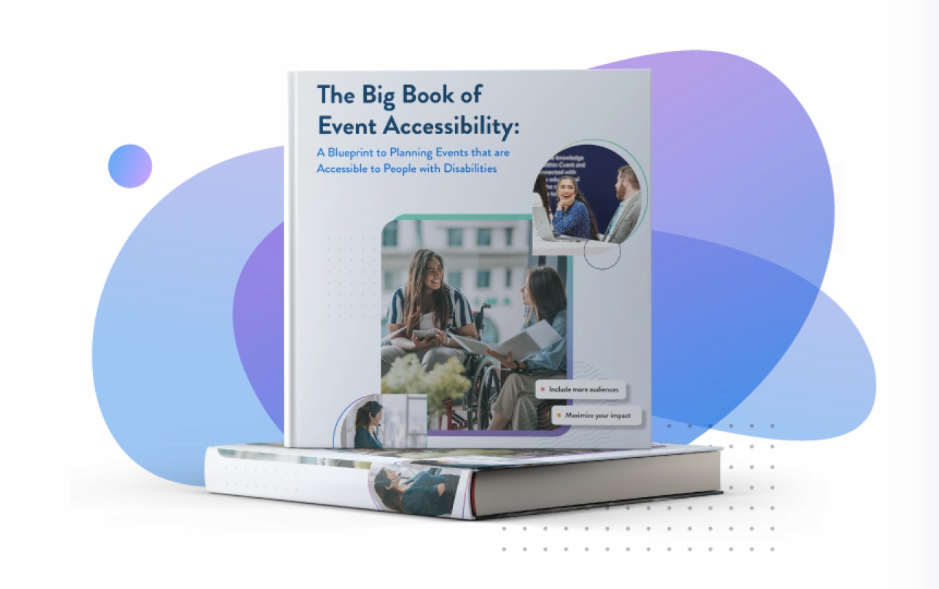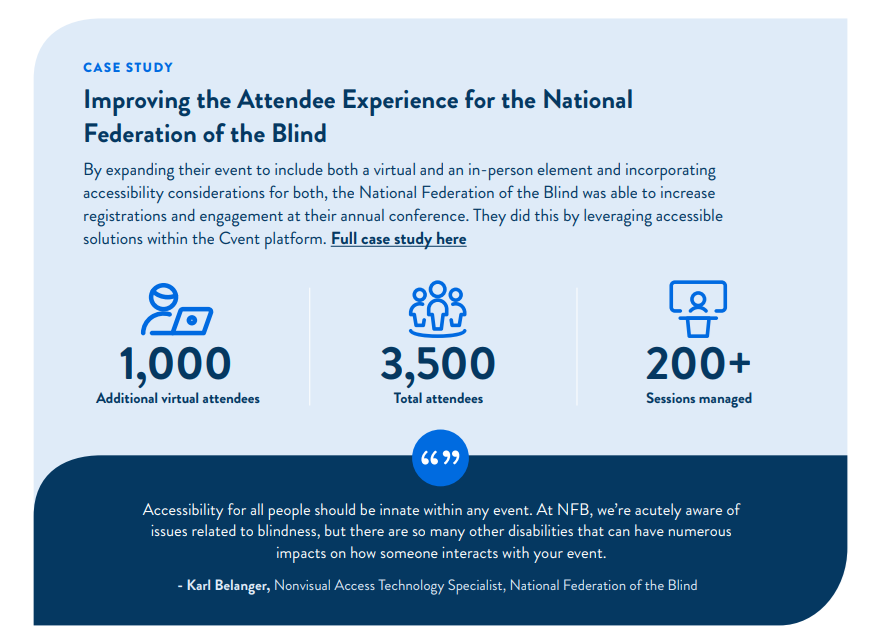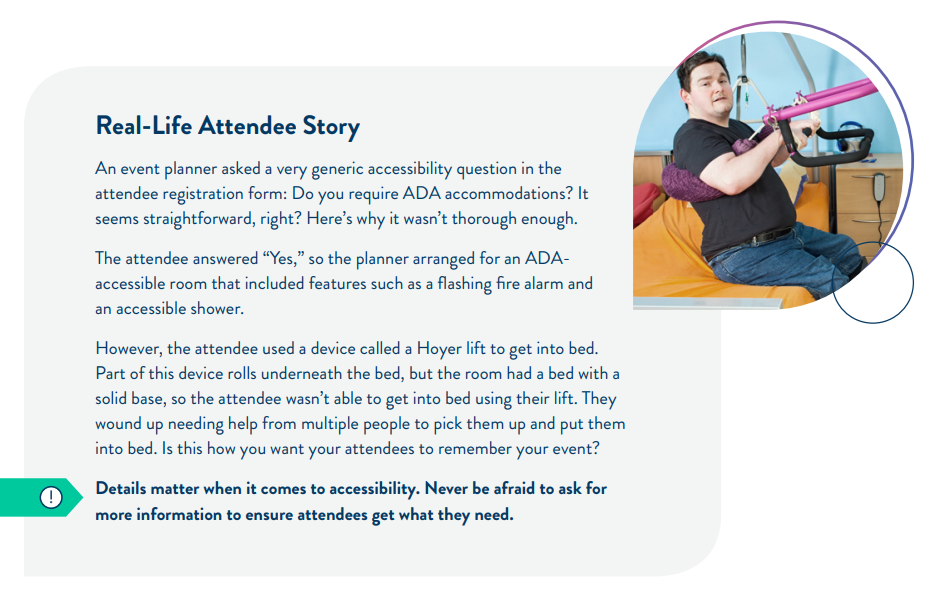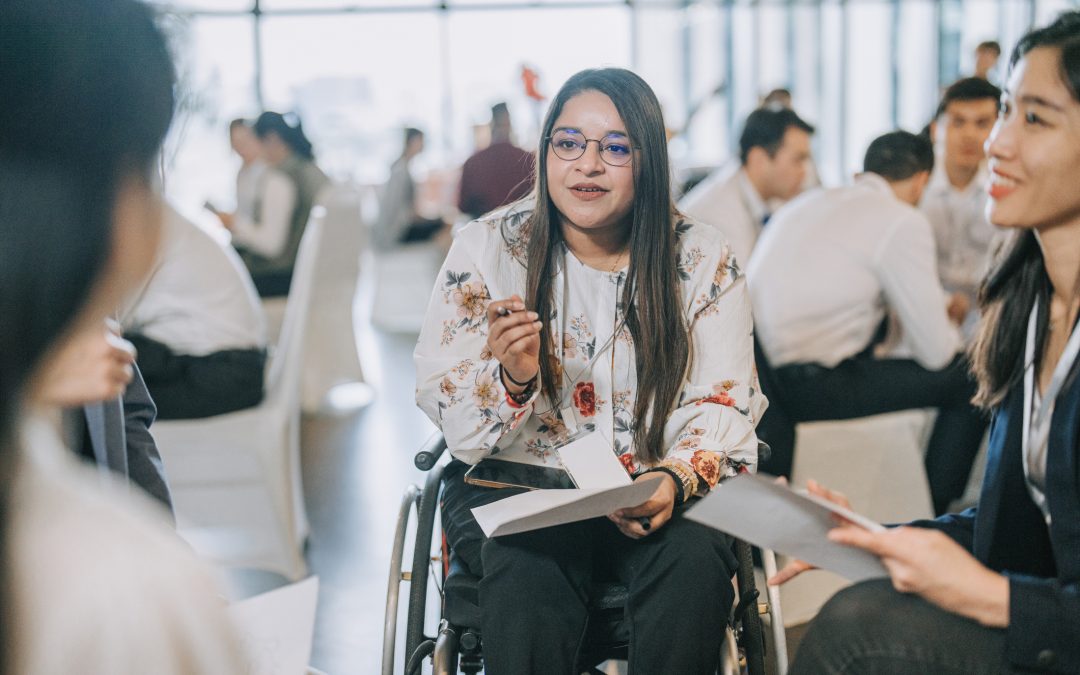Looking for a one-stop resource to plan inclusive events? You’re in luck! Cvent’s Big Book of Event Accessibility is your go-to guide. This essential resource has all the information you need to welcome people with disabilities to your events and provide engaging experiences for everyone. You can download the full guide here, or take a look at some of the key points below.

Over 25% of event attendees are likely to have some kind of disability, but many event programs fail to incorporate the needs of attendees with disabilities into their planning and engagement strategies. This creates a problem not only for attendees but also for businesses.
What Is Accessibility?
Accessibility refers to environments, products, services, and experiences being easily navigable, usable, understandable, and enjoyable by individuals with diverse disabilities.
This involves several considerations, including physical access to buildings, usability of websites and digital tools, and availability of information in suitable formats for people with various disabilities.
Accessibility is all about eliminating barriers to participation. There are plenty of technical definitions, but the overall goal is to make sure that whatever you’re planning is designed to be experienced by the widest range of people possible, regardless of their physical or cognitive abilities.
Why Make Your Event Accessible?
There are three big reasons to put accessibility at the centre of your planning rather than adding it as an afterthought. It drives more innovation and inclusion, there’s significant ROI, and it helps protect your organization legally.

Planning Accessible Events
The format of event you choose to plan will ultimately determine where your budget goes and the nature of the event. Accessibility means different things in a virtual environment compared to a physical one, and the type of event you choose to put on will ultimately inform the kind of resources required to make it happen.
As such, you should ask yourself does this need to be an in-person, virtual, or hybrid event?
Planning an accessible in-person event will add some line items to your budget. Here are a few things to consider:
- Rental or purchase of assistive technology devices, such as hearing loops or scooters
- Fees for sign language interpreters and/or real-time captioning services
- Transportation costs for attendees with disabilities, such as accessible transportation options or, in some cases, reimbursement for taxi fares
- Printing of materials in multiple formats, including large print and braille
- Purchase of accessible seating options or modifications to seating arrangements
- Site modifications, such as portable ramps
- Staff training on disability etiquette, accessibility protocols, and assistance techniques
- Accommodation costs for speakers or presenters with disabilities, such as accessible hotel rooms or travel assistance
- Design and printing of signage with accessibility information and directions
- Catering expenses for providing various food options to accommodate dietary restrictions and allergies
- Health and safety equipment, such as masks, hand sanitizer, and air purifiers
- Costs associated with implementing feedback mechanisms to improve accessibility for future events.
For virtual events, your list may include:
- Subscription or licensing fees for accessibly designed virtual event platforms or software
- Costs associated with hiring technical support or IT professionals to manage the virtual event platform
- Fees for live captioning and/or sign language interpretation services for virtual presentations
- Purchase or rental of equipment, such as webcams, microphones, or lighting to improve audio and video quality
- Training expenses for speakers or presenters on virtual presentation techniques and accessibility best practices
- Translation services for providing multilingual support during virtual events
- Accessibility audits to ensure virtual event platforms and materials are accessible to participants with disabilities.
Where budget approval is required, your internal decision-makers may need you to make a case for designing accessible events. In most cases, these decision-makers would like to put on an accessible event, but still have to account for providing ROI
for an increase on the balance sheet.
Advocate for your position by having absolute clarity on leadership’s goals and KPIs for your events and then build your case around those.

Venue and Vendor Sourcing
One of the most important parts of planning an accessible event is making sure you choose the right venue. As you evaluate your candidates, go armed with a checklist to help you qualify them.
- Can you reserve parking spaces for people who need them most?
- Is there ample space for mobility aids?
- Do doors have automatic openers, or can they be propped open for easy access?
- Are there lips or steps that prevent wheelchair access to key areas?
- Is the main entrance to the venue accessible? If not, is there an alternative accessible entrance that’s dignified (no back alleys)? Will it remain unlocked during your event?
- Is the approach to the venue solid ground, or will you need a temporary pathway? Soft mud and loose gravel can be problematic for many.
- Does the venue have step-free access throughout? Can the elevators be accessed without having to ask for a key? Are ramps of a gentle gradient (1:20), and do they have handrails on either side?
- What signage does the venue offer? Is the signage large and in high contrast? Is it embossed or in braille? If not, can you put up your own signs?
- Is there a loop system in your meeting room for hearing aid users? If so, is it working? Does anyone know how to switch it on or adjust the volume? Will that person be there when you hold your event in the building?
- Does the venue offer accessible toilets and gender-neutral toilets?
- Are there visual (flashing) fire alarms in private spaces, such as toilets, to alert delegates who are deaf or hard of hearing? If not, consider what you must do in case of a fire alarm.
- Is space available for a low-sensory room?
- Are electrical outlets available in seating areas for attendees to plug in adaptive devices, including laptops?
- Is there somewhere close by where service animals can drink water and relieve themselves?
- Do the chair options accommodate all body sizes?
Be sure to communicate accessibility requirements to all vendors clearly and in writing well ahead of the event. You can even make these stipulations part of your vendor agreements.
For video service providers, this can mean ensuring the crew knows to keep an ASL interpreter on screen at all times. For food vendors, it may mean requiring them to list all ingredients prominently on their
menus and provide bendable plastic straws.



